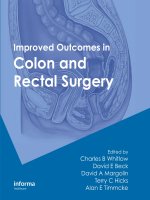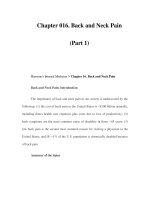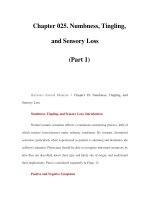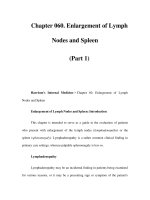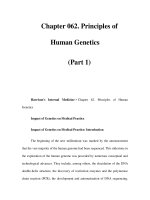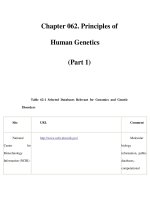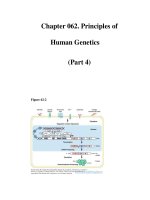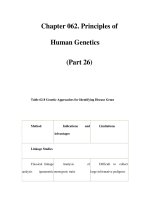BASIC HUMAN ANATOMY - PART 1 ppsx
Bạn đang xem bản rút gọn của tài liệu. Xem và tải ngay bản đầy đủ của tài liệu tại đây (239.17 KB, 25 trang )
U. S. ARMY MEDICAL DEPARTMENT CENTER AND SCHOOL
FORT SAM HOUSTON, TEXAS 78234
MD0006
BASIC HUMAN ANATOMY
EDITION 100
DEVELOPMENT
This subcourse reflects the current thought of the Academy of Health Sciences and
conforms to printed Department of the Army doctrine as closely as currently possible.
Development and progress render such doctrine continuously subject to change.
When used in this publication, words such as "he," "him," "his," and "men" are intended
to include both the masculine and feminine genders, unless specifically stated
otherwise or when obvious in context.
ADMINISTRATION
Students who desire credit hours for this correspondence subcourse must meet
eligibility requirements and must enroll through the Nonresident Instruction Branch of
the U.S. Army Medical Department Center and School (AMEDDC&S).
Application for enrollment should be made at the Internet website:
. You can access the course catalog in the upper right corner.
Enter School Code 555 for medical correspondence courses. Copy down the course
number and title. To apply for enrollment, return to the main ATRRS screen and scroll
down the right side for ATRRS Channels. Click on SELF DEVELOPMENT to open the
application and then follow the on screen instructions.
In general, eligible personnel include enlisted personnel of all components of the U.S.
Army who hold an AMEDD MOS or MOS 18D. Officer personnel, members of other
branches of the Armed Forces, and civilian employees will be considered eligible based
upon their AOC, NEC, AFSC or Job Series which will verify job relevance. Applicants
who wish to be considered for a waiver should submit justification to the Nonresident
Instruction Branch at e-mail address:
For comments or questions regarding enrollment, student records, or shipments,
contact the Nonresident Instruction Branch at DSN 471-5877, commercial (210) 221-
5877, toll-free 1-800-344-2380; fax: 210-221-4012 or DSN 471-4012, e-mail
, or write to:
NONRESIDENT INSTRUCTION BRANCH
AMEDDC&S
ATTN: MCCS-HSN
2105 11TH STREET SUITE 4191
FORT SAM HOUSTON TX 78234-5064
MD0006 i
TABLE OF CONTENTS
Lesson Paragraphs Page
INTRODUCTION vi
1 INTRODUCTION TO BASIC HUMAN ANATOMY
Section I. General 1-1 1-6 1-2
II. Anatomical Terminology 1-7 1-11 1-5
III. Cells 1-12 1-15 1-9
Exercises 1-12
2 TISSUES OF THE BODY
Section I. General 2-1 2-3 2-2
II. Epithelial Tissues 2-4 2-6 2-2
III. Connective Tissues 2-7 2-13 2-4
IV. Muscle Tissues 2-14 2-15 2-6
V. Nervous Tissue 2-16 2-17 2-7
Exercises 2-9
3 THE HUMAN INTEGUMENTARY AND FASCIAL SYSTEMS
Section I. General 3-1 3-2 3-2
II. The Human Integumentary
System 3-3 3-8 3-3
III. The Fascial System of the
Human Body 3-9 3-11 3-6
IV. Serous Cavities of the
Human Body 3-12 3-14 3-6
Exercises 3-9
4 THE HUMAN SKELETAL SYSTEM
Section I. General 4-1 4-3 4-3
II. Bone As An Individual
Organ 4-4 4-6 4-4
III. Arthrology The Study of
Joints (Articulations) 4-7 4-11 4-7
IV. The Human Skeleton 4-12 4-14 4-12
Exercises 4-27
MD0006 ii
5 THE HUMAN MUSCULAR SYSTEM
Section I. The Skeletal Muscle 5-1 5-4 5-2
II. Some Elementary Skeleto-
Muscular Mechanics 5-5 5-8 5-6
Exercises 5-10
6 THE HUMAN DIGESTIVE SYSTEM
Section I. Introduction 6-1 6-2 6-2
II. The Supragastric
Structures 6-3 6-5 6-3
III. The Stomach 6-6 6-7 6-6
IV. The Small Intestines and
Associated Glands 6-8 6-11 6-6
V. The Large Intestines 6-12 6-14 6-8
VI. Associated Protective
Structures 6-15 6-16 6-9
Exercises 6-10
7 THE HUMAN RESPIRATORY SYSTEM AND BREATHING
Section I. The Respiratory System 7-1 7-5 7-2
II. Breathing and Breathing
Mechanisms in Humans 7-6 7-8 7-9
Exercises 7-11
8 THE HUMAN UROGENITAL SYSTEMS
Section I. The Human Urinary System 8-1 8-6 8-2
II. Introduction to Human
Genital (Reproductive)
Systems 8-7 8-9 8-6
III. The Human Female Genital
(Reproductive) System 8-10 8-13 8-7
IV. The Human Male Genital
(Reproductive) System 8-14 8-16 8-10
Exercises 8-14
MD0006 iii
9 THE HUMAN CARDIOVASCULAR AND LYMPHATIC SYSTEMS
Section I. Introduction 9-1 9-3 9-3
II. The Human Cardiovascular
System 9-4 9-8 9-4
III. The Human Lymphatic System 9-9 9-10 9-16
Exercises 9-18
10 THE HUMAN ENDOCRINE SYSTEM
Section I. Introduction 10-1 10-2 10-2
II. The Pituitary Body 10-3 10-5 10-4
III. The Thyroid Gland 10-6 10-8 10-5
IV. The Parathyroid Glands 10-9 10-10 10-6
V. The Pancreatic Islets
(Islands of Langerhans) 10-11 10-12 10-6
VI. The Suprarenal (Adrenal)
Glands 10-13 10-15 10-6
VII. The Gonads 10-16 10-18 10-7
Exercises 10-8
11 THE HUMAN NERVOUS SYSTEM
Section I. Introduction 11-1 11-2 11-3
II. The Neuron and Its
"Connections" 11-3 11-7 11-3
III. The Human Central Nervous
System 11-8 11-13 11-7
IV. The Peripheral Nervous
System (PNS) 11-14 11-15 11-15
V. The Autonomic Nervous
System (ANS) 11-16 11-18 11-19
VI. Pathways of the Human
Nervous System 11-19 11-21 11-21
VII. The Special Sense of Smell
(Olfaction) 11-22 11-23 11-23
VIII. The Special Sense of Taste
(Gustation) 11-24 11-25 11-23
IX. The Special Sense of Vision
(Sight) 11-26 11-29 11-24
X. The Special Sense of Hearing
(Auditory) 11-30 11-33 11-30
XI. The Special Sense of
Equilibrium (Balance) 11-34 11-37 11-35
MD0006 iv
XII. Controls in the Human
Nervous System 11-38 11-39 11-37
Exercises 11-39
MD0006 v
LIST OF ILLUSTRATIONS
Figure Page
1-1 Regions of the human body 1-4
1-2 Anatomical position and medial-lateral relationships 1-7
1-3A The sagittal plane 1-8
1-3B The horizontal plane 1-8
1-3C The frontal plane 1-8
1-4 A "typical" animal cell (as seen in an electron microscope) 1-10
1-5 Planes of the body (exercise 14) 1-14
1-6 Directions (exercise 15) 1-15
1-7 Directions upon members (exercise 16) 1-16
1-8 A "typical" animal cell (exercise 18) 1-17
2-1 Epithelial cells 2-3
2-2 Types of epithelial tissues 2-3
2-3 Types of muscle tissue 2-7
2-4 A neuron 2-8
2-5 A synapse 2-8
3-1 The integument and related structures 3-2
3-2 The integumentary derivatives (appendages) 3-4
3-3 A bursa the simplest serous cavity 3-7
4-1 A mature long bone (femur) 4-4
4-2 A "typical synovial joint" diagrammatic 4-9
4-3A Anterior view of the human skeleton 4-13
4-3B Posterior view of the human skeleton 4-14
4-4 A typical vertebra (superior and side views) 4-15
4-5 The human thorax with bones of the shoulder region 4-17
4-6 The human skull (front and side views) 4-18
4-7 A general pattern of the upper and lower members 4-21
4-8 The human scapula and clavicle (pectoral girdle) 4-22
4-9 The humerus, radius, and ulna 4-23
4-10 The human hand 4-24
4-11 The bony pelvis (two pelvic bones and sacrum) 4-24
4-12 The femur, tibia, and fibula (anterior views) 4-25
4-13 The human foot 4-26
5-1 Skeletal and facial muscles, anterior view 5-4
5-2 Skeletal and facial muscles, posterior view 5-5
5-3 Types of lever systems 5-7
5-4 A simple pulley (the human knee mechanism) 5-7
5-5 The skeleto-muscular unit (arm-forearm flexion (3rd class lever system)) 5-8
6-1 The human digestive system 6-2
6-2 Anatomy of the oral complex 6-4
6-3 Section of a tooth and jaw 6-4
MD0006 vi
7-1 The human respiratory system 7-3
7-2 Supralaryngeal structures 7-4
7-3 The larynx 7-7
7-4 Infralaryngeal structures ("respiratory tree") 7-8
8-1 The human urinary system 8-2
8-2 A section of a human kidney 8-3
8-3 A "typical" nephron 8-4
8-4 The human female genital system 8-8
8-5 The human male genital system (continued) 8-11
9-1 Scheme of blood vessels 9-6
9-2 The human heart 9-8
9-3 Scheme of heart valves 9-9
9-4 Cardiovascular circulatory patterns 9-11
9-5 Main arteries of the human body 9-13
9-6 Main veins of the human body 9-15
9-7 The human lymphatic system 9-16
10-1 The endocrine glands of the human body and their locations 10-3
11-1 A "typical" neuron 11-4
11-2 A synapse 11-6
11-3 A neuromuscular junction 11-7
11-4 The human central nervous system (CNS) 11-8
11-5A Human brain (side view) 11-9
11-5B Human brain (bottom view) 11-10
11-6 A cross section of the spinal cord 11-13
11-7 A schematic diagram of the meninges, as seen in side view of the CNS 11-14
11-8 A "typical" spinal nerve, with a cross section of the spinal cord 11-16
11-9 The general reflex arc 11-18
11-10 A horizontal section of the eyeball 11-25
11-11 Cellular detail of the retina 11-26
11-12 A frontal section of the human ear 11-31
11-13 The labyrinths of the internal ear 11-32
11-14 Diagram of the scalae 11-34
11-15 Diagram of semicircular duct orientation 11-36
MD0006 vii
LIST OF TABLES
Table Page
4-1 The tissues and functions of structures of
a "typical" synovial articulation 4-11
4-2 Bones of the upper and lower members 4-20
7-1 The main divisions of the respiratory system 7-4
MD0006 viii
CORRESPONDENCE COURSE OF THE
U.S. ARMY MEDICAL DEPARTMENT CENTER AND SCHOOL
SUBCOURSE MD0006
BASIC HUMAN ANATOMY
INTRODUCTION
In this subcourse, you will study basic human anatomy. Anatomy is the study of
body structure. Physiology is the study of body functions. Anatomy and physiology are
two subject matter areas that are vitally important to most medical MOSs. Do your best
to achieve the objectives of this subcourse. As a result, you will be better able to
perform your job or medical MOS.
Subcourse Components:
This subcourse consists of 11 lessons and an examination. The lessons are:
Lesson 1, Introduction to Basic Human Anatomy.
Lesson 2, Tissues of the Body.
Lesson 3, The Human Integumentary and Fascial Systems.
Lesson 4, The Human Skeletal System.
Lesson 5, The Human Muscular System.
Lesson 6, The Human Digestive System.
Lesson 7, The Human Respiratory System and Breathing.
Lesson 8, The Human Urogenital Systems.
Lesson 9, The Human Cardiovascular and Lymphatic Systems.
Lesson 10, The Human Endocrine System.
Lesson 11, The Human Nervous System.
Credit Awarded:
Upon successful completion of this subcourse, you will be awarded 26 credit
hours.
MD0006 ix
Material Furnished:
In addition to this subcourse booklet, you are furnished an examination answer
sheet and an envelope. Answer sheets are not provided for individual lessons in this
subcourse because you are to grade your own lessons. Exercises and solutions for all
lessons are contained in this booklet.
You must furnish a #2 pencil to be used when marking the examination answer
sheet.
You may keep the subcourse.
Procedures for Subcourse completion:
You are encouraged to complete the subcourse lesson by lesson. When you have
completed all of the lessons to your satisfaction, fill out the examination answer sheet
and mail it to the AMEDDC&S along with the Student Comment Sheet in the envelope
provided. Be sure that your name, rank, social security number, and address is on all
correspondence sent to the AMEDDC&S. You will be notified by return mail of the
examination results. Your grade on the examination will be your rating for the
subcourse.
Study Suggestions:
Here are some suggestions that may be helpful to you in completing this
subcourse:
Read and study each lesson assignment carefully.
After reading and studying the first lesson assignment, work the lesson exercises
for the first lesson, marking your answers in the lesson booklet. Refer to the text
material as needed.
When you have completed the exercises to your satisfaction, compare your
answers with the solution sheet located at the end of the lesson. Reread the
referenced material for any questions answered incorrectly.
After you have successfully completed one lesson, go to the next lesson and
repeat the above procedures.
When you have completed all of the lessons, complete the examination. Reread
the subcourse material as needed. We suggest that you mark your answers in the
subcourse booklet. When you have completed the examination items to your
satisfaction, transfer your responses to the examination answer sheet.
MD0006 x
Student Comment Sheet:
Provide us with your suggestions and comments by filling out the Student
Comment Sheet found at the back of this booklet and returning it to us with your
examination answer sheet.
MD0006 1-1
LESSON ASSIGNMENT
LESSON 1 Introduction to Basic Human Anatomy.
TEXT ASSIGNMENT Paragraphs 1-1 through 1-15.
LESSON OBJECTIVES After completing this lesson, you should be able to:
1-1. Define anatomy.
1-2. Characterize individuals according to body type
and state clinical significance.
1-3. Identify kinds of anatomical studies.
1-4. Trace the organization of the human body into
cells, tissues, organs, organ systems, and the
total organism.
1-5. List the parts of an upper member and the parts
of a lower member.
1-6. Identify a reason for studying terminology.
1-7. Define the anatomical position.
1-8. Given drawings illustrating planes and
directions, name the planes and directions.
1-9. Define the cell and match names of major
components with drawings representing them.
SUGGESTION After completing the assignment, complete the
exercises at the end of this lesson. These exercises
will help you to achieve the lesson objectives.
MD0006 1-2
LESSON 1
INTRODUCTION TO BASIC HUMAN ANATOMY
Section I. GENERAL
1-1. DEFINITIONS
a. Anatomy is the study of the structure of the body. Often, you may be more
interested in functions of the body. Functions include digestion, respiration, circulation,
and reproduction. Physiology is the study of the functions of the body.
b. The body is a chemical and physical machine. As such, it is subject to certain
laws. These are sometimes called natural laws. Each part of the body is engineered to
do a particular job. These jobs are functions. For each job or body function, there is a
particular structure engineered to do it.
c. In the laboratory, anatomy is studied by dissection (SECT = cut, DIS = apart).
1-2. BODY TYPES
No two human beings are built exactly alike, but we can group individuals into
three major categories. These groups represent basic body shapes.
MORPH = body, body form
ECTO = all energy is outgoing
ENDO = all energy is stored inside
MESO = between, in the middle
ECTOMORPH = slim individual
ENDOMORPH = broad individual
MESOMORPH = body type between the two others, "muscular" type
Ectomorphs, slim persons, are more susceptible to lung infections. Endomorphs are
more susceptible to heart disease.
1-3. NOTE ON TERMINOLOGY
a. Each profession and each science has its own language. Lawyers have legal
terminology. Physicians and other medical professions and occupations have medical
MD0006 1-3
terminology. Accountants have debits, credits, and balance sheets. Physicists have
quantums and quarks. Mathematicians have integrals and differentials. Mechanics
have carburetors and alternators. Educators have objectives, domains, and curricula.
b. To work in a legal field, you should know the meaning of quid pro quo. To
work in a medical field, you should know the meanings of terms such as proximal, distal,
sagittal, femur, humerus, thorax, and cerebellum.
1-4. KINDS OF ANATOMICAL STUDIES
a. Microscopic anatomy is the study of structures that cannot be seen with the
unaided eye. You need a microscope.
b. Gross anatomy by systems is the study of organ systems, such as the
respiratory system or the digestive system.
c. Gross anatomy by regions considers anatomy in terms of regions such as the
trunk, upper member, or lower member.
d. Neuroanatomy studies the nervous system.
e. Functional anatomy is the study of relationships between functions and
structures.
1-5. ORGANIZATION OF THE HUMAN BODY
The human body is organized into cells, tissues, organs, organ systems, and the
total organism.
a. Cells are the smallest living unit of body construction.
b. A tissue is a grouping of like cells working together. Examples are muscle
tissue and nervous tissue.
c. An organ is a structure composed of several different tissues performing a
particular function. Examples include the lungs and the heart.
d. Organ systems are groups of organs which together perform an overall
function. Examples are the respiratory system and the digestive system.
e. The total organism is the individual human being. You are a total organism.
MD0006 1-4
Figure 1-1. Regions of the human body.
1-6. REGIONS OF THE HUMAN BODY (FIGURE 1-1)
The human body is a single, total composite. Everything works together. Each
part acts in association with ALL other parts. Yet, it is also a series of regions. Each
region is responsible for certain body activities. These regions are:
a. Back and Trunk. The torso includes the back and trunk. The trunk includes
the thorax (chest) and abdomen. At the lower end of the trunk is the pelvis. The
perineum is the portion of the body forming the floor of the pelvis. The lungs, the heart,
and the digestive system are found in the trunk.
MD0006 1-5
b. Head and Neck. The brain, eyes, ears, mouth, pharynx, and larynx are
found in this region.
c. Members.
(1) Each upper member includes a shoulder, arm, forearm, wrist, and hand.
(2) Each lower member includes a hip, thigh, leg, ankle, and foot.
Section II. ANATOMICAL TERMINOLOGY
1-7. ANATOMICAL TERMINOLOGY
a. As mentioned earlier, you must know the language of a particular field to be
successful in it. Each field has specific names for specific structures and functions.
Unless you know the names and their meanings, you will have trouble saying what you
mean. You will have trouble understanding what others are saying. You will not be
able to communicate well.
b. What is a scientific term? It is a word that names or gives special information
about a structure or process. Some scientific terms have two or three different parts.
These parts are known as a PREFIX, a ROOT (or base), and a SUFFIX. An example is
the word subcutaneous.
SUB = below prefix
CUTIS = skin root
SUBCUTANEOUS = below the skin
A second example is the word myocardium.
MYO = muscle prefix
CARDIUM = heart root
MYOCARDIUM = muscular wall of the heart
MD0006 1-6
A third example is the word tonsillitis.
TONSIL = tonsil (a specific organ) root
ITIS = inflammation suffix
TONSILLITIS = an inflammation of the tonsils
1-8. THE ANATOMICAL POSITION
The anatomical position is an artificial posture of the human body (see figure
1-2). This position is used as a standard reference throughout the medical profession.
We always speak of the parts of the body as if the body were in the anatomical position.
This is true regardless of what position the body is actually in. The anatomical position
is described as follows:
a. The body stands erect, with heels together.
b. Upper members are along the sides, with the palms of the hands facing
forward.
c. The head faces forward.
1-9. PLANES OF THE BODY
See figures 1-3A through 1-3C for the imaginary planes used to describe the
body.
a. Sagittal planes are vertical planes that pass through the body from front to
back. The median or midsagittal plane is the vertical plane that divides the body into
right and left halves.
b. Horizontal (transverse) planes are parallel to the floor. They are
perpendicular to both the sagittal and frontal planes.
c. Frontal (coronal) planes are vertical planes which pass through the body from
side to side. They are perpendicular to the sagittal plane.
MD0006 1-7
Figure 1-2. Anatomical position and medial-lateral relationships.
MD0006 1-8
A B C
Figure 1-3, A. The sagittal plane. B. The horizontal plane. C. The frontal plane.
1-10. DIRECTIONS
a. Superior, Inferior. Superior means above. Inferior means below.
b. Anterior, Posterior.
(1) Anterior (or ventral) refers to the front of the body.
(2) Posterior (or dorsal) refers to the back of the body.
c. Medial, Lateral. Medial means toward or nearer the midline of the body.
Lateral means away from the midline or toward the side of the body.
d. Superficial, Deep. Superficial means closer to the surface of the body.
Deep means toward the center of the body or body part.
e. Proximal, Distal. Proximal and distal are terms applied specifically to the
limbs. Proximal means nearer to the shoulder joint or the hip joint. Distal means further
away from the shoulder joint or the hip joint. Sometimes proximal and distal are used to
identify the "beginning" and "end" of the gut tract that portion closer to the stomach
being proximal while that further away being distal.
MD0006 1-9
1-11. NAMES
a. Names are chosen to describe the structure or process as much as possible.
An international nomenclature was adopted for anatomy in Paris in 1955. It does not
use the names of people for structures. (The single exception is the Achilles tendon at
the back of the foot and ankle.)
b. Names are chosen to identify structures properly. Names identify structures
according to shape, size, color, function, and/or location. Some examples are:
TRAPEZIUS MUSCLE
TRAPEZIUS = trapezoid (shape)
ADDUCTOR MAGNUS MUSCLE
AD = toward
DUCT = to carry (function)
MAGNUS = very large (size)
ERYTHROCYTE
ERYTHRO = red (color)
CYTE = cell
BICEPS BRACHII MUSCLE
BI = two
CEPS = head (shape)
BRACHII = of the arm (location)
Section III. CELLS
1-12. INTRODUCTION
A cell is the microscopic unit of body organization. The "typical animal cell" is
illustrated in figure 1-4. A typical animal cell includes a cell membrane, a nucleus, a
nuclear membrane, cytoplasm, ribosomes, endoplasmic reticulum, mitochondria, Golgi
apparatus, centrioles, and lysosomes.
MD0006 1-10
Figure 1-4. A "typical" animal cell (as seen in an electron microscope).
1-13. MAJOR COMPONENTS OF A "TYPICAL" ANIMAL CELL
a. Nucleus. The nucleus plays a central role in the cell. Information is stored in
the nucleus and distributed to guide the life processes of the cell. This information is in
a chemical form called nucleic acids. Two types of structures found in the nucleus are
chromosomes and nucleoli. Chromosomes can be seen clearly only during cell
divisions. Chromosomes are composed of both nucleic acid and protein.
Chromosomes contain genes. Genes are the basic units of heredity which are passed
from parents to their children. Genes guide the activities of each individual cell.
b. Cell Membrane. The cell membrane surrounds and separates the cell from
its environment. The cell membrane allows certain materials to pass through it as they
enter or leave the cell.
c. Cytoplasm. The semifluid found inside the cell, but outside the nucleus, is
called the cytoplasm.
MD0006 1-11
d. Mitochondria (Plural). Mitochondria are the "powerhouses" of the cell. The
mitochondria provide the energy wherever it is needed for carrying on the cellular
functions.
e. Endoplasmic Reticulum. The endoplasmic reticulum is a network of
membranes, cavities, and canals. The endoplasmic reticulum helps in the transfer of
materials from one part of the cell to the other.
f. Ribosomes. Ribosomes are "protein factories" in the cell. They are
composed mainly of nucleic acids which help make proteins according to instructions
provided by the genes.
g. Centrioles. Centrioles help in the process of cell division.
h. Lysosomes. Lysosomes are membrane bound spheres which contain
enzymes that can digest intracellular structures or bacteria.
1-14. CELL MULTIPLICATION (MITOSIS)
Individual cells have fairly specific life spans. Some types of cells have longer
life spans than others. During the processes of growth and repair, new cells are being
formed. The usual process of cell multiplication is called mitosis. There are two
important factors to consider:
a. From one cell, we get two new cells.
b. The genes of the new cells are identical (for all practical purposes) to the
genes of the original cell.
1-15. HYPERTROPHY/HYPERPLASIA
Hypertrophy and hyperplasia are two ways by which the cell mass of the body
increases.
a. With HYPERTROPHY, there is an increase in the size of the individual cells.
No new cells are formed. An example is the enlargement of muscles due to exercise by
the increased diameter of the individual striated muscle fibers.
b. With HYPERPLASIA, there is an increase in the total number of cells. An
example of abnormal hyperplasia is cancer.
c. ATROPHY is seen when there is a loss of cellular mass.
Continue with Exercises
MD0006 1-13
5. What is a cell?
6. What is a tissue?
7. What is an organ?
8. What is an organ system?
9. What is the total organism?
10. What are the parts of the upper member? , ,
, , and .
11. What are the parts of the lower member? , ,
, , and .
12. What is one reason for studying terminology?
13. Describe the anatomical position.
a. The body stands with together.
b. The upper members are along the with palms
facing .
c. The head faces .
MD0006 1-14
14. Each plane in figure 1-5 is marked by a letter a, b, c, or d. Write the name of
each plane in the appropriate space below.
a. plane.
b. plane.
c. plane.
d. plane.
Figure 1-5. Planes of the body (exercise 14).
